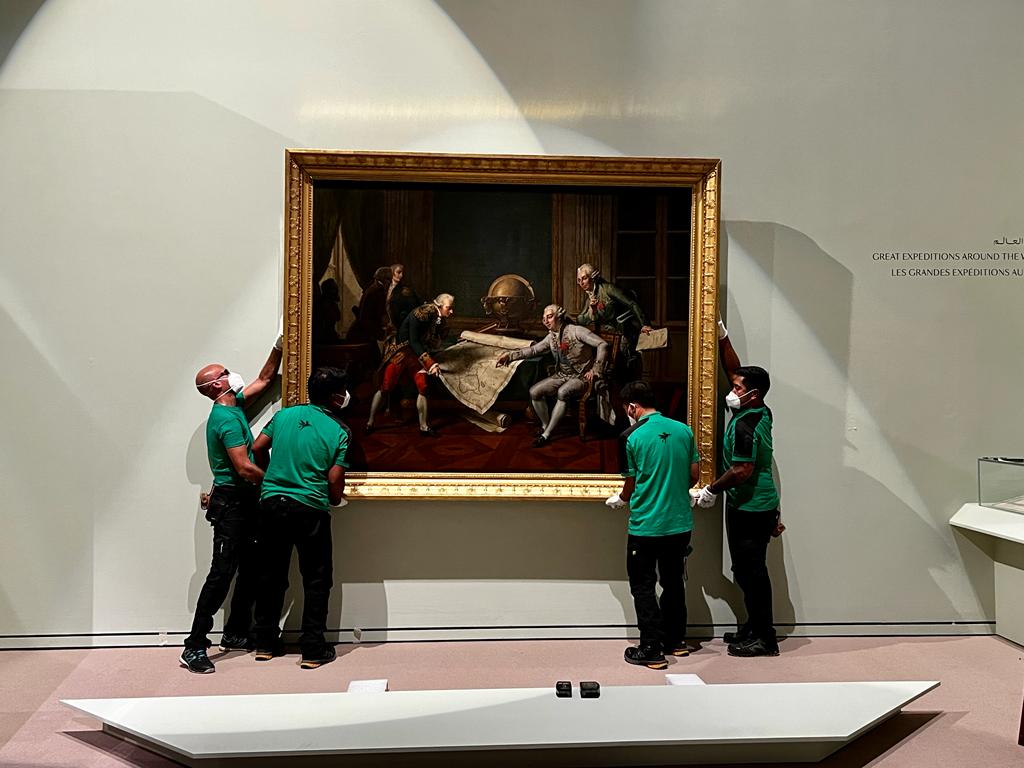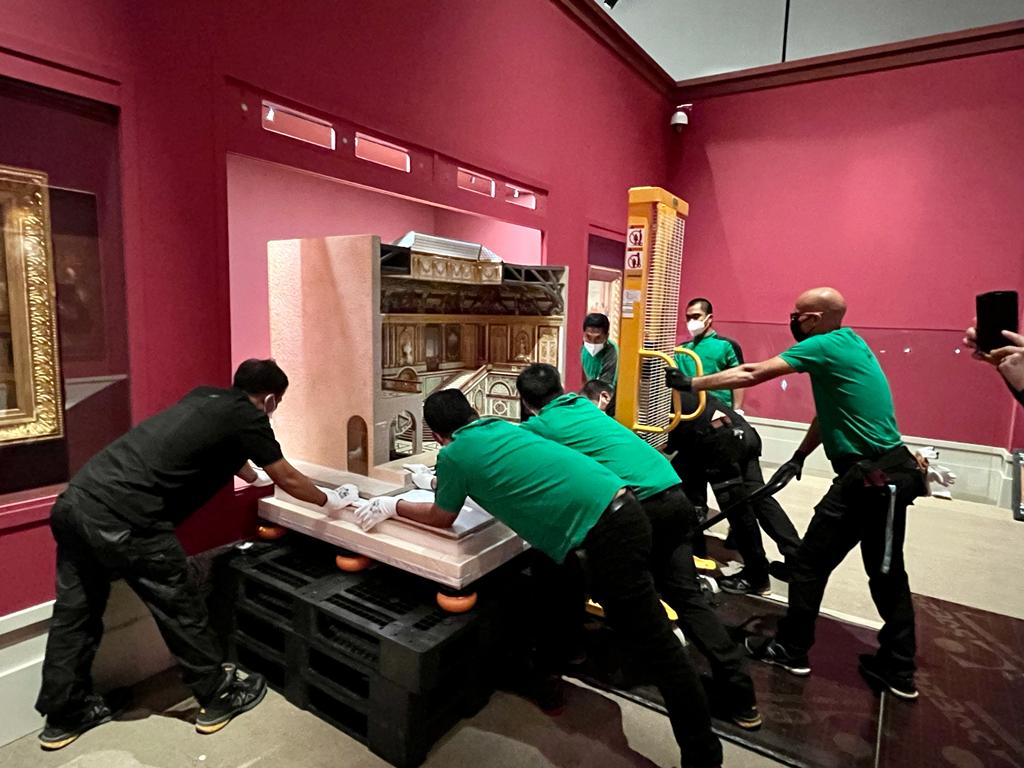Versailles & the world exhibition – A look behind the scenes
In a context where international cultural exchanges have been adversely affected and where global cooperation is more essential than ever, the theme of openness embodied by the new exhibition “Versailles & the world”, presented at Louvre Abu Dhabi from 26 January to 4 June 2022, sends an even stronger message.
Co organised by France Muséums, the Palace of Versailles and the Louvre Abu Dhabi, “Versailles & the world” was designed, produced and installed during the pandemic and consequently had to cope with a host of constraints and unforeseen problems. It demonstrates that the global crisis affecting us all can also be an opportunity to step back and think about new ways of constructing exhibitions.
As an international museum consultancy this is the message of France Muséums, whose determined and innovative teams made it possible to open the exhibition on schedule. For over a year, they worked with the curators Hélène Delalex, Curator, Furniture and Decorative Arts and Bertrand Rondot, Chief Curator, Furniture and Decorative Arts, at the musée national des châteaux de Versailles et de Trianon, as well as teams from partner institutions and lenders, to prepare this exhibition showcasing the wonders of the Palace, highlighting its openness to the world and its central role in cultural, diplomatic and scientific exchanges for several centuries.
Preparing exhibitions during the pandemic has revealed genuine teamwork and an ability to adapt methods of production, transportation and installation. For two years, France Muséums has provided consultancy to its partners, has pooled transportation resources on a global scale, organised on-line hybrid installations, obtained delegations from lenders and negotiated optimised loan schedules. These initiatives are the early signs of deeper change and raise wide-reaching questions about the sustainable management of museums and their collections. The health crisis has ushered in a new paradigm where adaptation is key and each exhibition project begins with a blank canvas.
PREPARATORY WORK AND FORGING ROBUST CONNECTIONS
The strength of this exhibition lies mainly in the preparatory work that began over a year before it opened, carried out by the France Muséums teams headed by Alice Rivollier, Project Manager and Deputy to the Exhibitions and Publications Director; Sandra Mazière, Chief Registrar and Deputy to the Exhibitions and Publications Director; Flora Roy, Senior Temporary exhibitions Officer; and Aurore Tisserand, Chief Registrar – Permanent Galleries & Acquisitions, in collaboration with the curatorial teams.
Evolving in these uncertain times requires a robust methodology in order to anticipate all possible scenarios up to the final exhibition assembly stage. It involves efficiently coordinating transport, preparing alternative schedules, optimising the number of people present during installation, managing insurance, and coordinating with lenders, partners and service providers (haulage firms, display makers, lighting technicians, scenographers, etc.). This operational planning is made possible by a long-standing relationship of trust between France Muséums and its network of partner institutions, of which the Palace of Versailles has been the central pivot for this exhibition.
“It was very reassuring to see that the France Muséums staff were able to cope with difficulties while always maintaining a pleasant, good-humoured approach […] and applying highly efficient organisational skills thanks to the work of Aurore, Sandra, Alice, Flora and their teams[…] The on-site staff at Louvre Abu Dhabi, partners such as Bovis Fine Art and extremely devoted and conscientious external teams made unstinting use of their time and creativity to deliver the project”. Bertrand Rondot, co-curator of the exhibition.
“For the first time in my career, Senior Management raised the possibility that the opening schedule might be compromised due to considerations of public health.
This eventuality was discussed with a great deal of calm and understanding, and the way everyone worked together as a highly committed team meant that we were able to make up for lost time and open the exhibition as originally planned.
This experience was very enriching from a professional point of view as a whole range of different scenarios came up, especially as the exhibition had a large number of showcases and art objects that were particularly difficult to display to display and delicate to manipulate. From a personal point of view, I’ll remember the wonderful people I worked with on the project.” Hélène Delalex, co-curator of the exhibition.
In accordance with the agreement between the French and Emirati governments, it is the responsibility of France Muséums its consultant teams to organise temporary exhibitions held at the Louvre Abu Dhabi. This includes designing exhibitions, installing exhibits, organising loans and shipping artworks to Abu Dhabi, which is 6,000 km from France.
The caring and trusting relationship that we have built up over the years has allowed us to cope with the constraints relating to the health crisis and obtain international delegations for shipping artworks to Abu Dhabi when our usual providers were unable to do so.
France Muséums is eager to thank all concerned for their adaptability and resilience. The pandemic has brought us back to the very essence of our profession, namely ensuring that a wide variety of visitors are able to admire masterworks from many different sources (in this case, the Musée national des châteaux de Versailles et de Trianon, the Bibliothèque Nationale de France, the Musée des Arts Décoratifs, the British Royal Collections, etc.).
COLLECTIVE STRENGTH AND EXPERTISE
While ensuring the safety of people and artworks, and in accordance with the exhibition design, the France Muséums teams were able to adapt to the context and constraints of the health crisis. We made this exhibition possible by working more closely than ever with our partners, supporting one another and communicating at every stage. The strength of France Muséums also lies in our ability to rapidly mobilise our in-house teams to cope with additional workload.
A genuine team spirit developed between all the different skill centres, in an unprecedented way. Usually, each person involved in the project contributes their expertise at a particular time, like a member of an orchestra where each instrument has a predefined role to play and follows the score. Project Manager and Deputy to the Exhibitions and Publications Director Alice Rivollier initiates a different approach for “Versailles & the world”, based on listening to one another’s needs and working in project mode. “The aim was to abandon the usual silo-based approach in order to increase manpower”. Each person was asked not only to contribute his or her expertise, but also to provide advice and share knowledge at every stage of the installation process. This involved thinking about the exhibition layout, advising on display solutions and lighting, and so on. It meant we could tap into a host of useful ideas.
For Chief Registrar and Deputy to the Exhibitions and Publications Director Sandra Mazière, the exhibition represented a tipping point in terms of production and installation methods. Each person involved, depending on his or her skills, was able to help finish the paintwork, open the crates, and even put together the displays—things they would have been unable to do if they had stuck strictly to their usual roles. The different partners were able to meet, communicate and understand each other’s skills and needs. Many opportunities emerged from the organisation and installation of “Versailles & the world”. More space was given to creativity, initiative and innovation at every stage of the project, and when we hit a problem or were unsure how to proceed, solutions were sometimes found by people with completely different roles or skillsets. Thinking outside the box in this way is an essential way of improving our working methods and stepping out of our comfort zones. When people with different skills share their ideas and points of view, it allows solutions to emerge and moves the project forward.
“I feel that I’ve put everything I’ve learned into practice […] It made me think about the way I approach exhibitions and installations, where I think it’s essential that the teams should work closely together as one.
We were able to move forward and solve the various problems that arose by pooling our knowledge, ideas and skills. You mustn’t compartmentalise: everyone has their own skills of course, and that’s why we all work together, but it’s vital to be able to share our different perspectives”.
Bertrand Rondot, co-curator, Versailles & the world
France Muséums would like once again to thank Katia Cartacheff, Olivia Davidson, Alice Rivollier, Sandra Mazière, Aurore Tisserand, Sabrina Mathieu, Clémence Derrien, Chloé Guillaume, Flora Roy, Lise Iguedjtal, Solène Mannant, Pauline Vernières, Mathilde Etot and Orlane Lefeuvre for their work. Many thanks to Bovis Fine Art and Aïnu for their support, and to Héléne Delalex and Bertrand Rondot for curating this majestic exhibition.




